Most high school students report adverse experiences during pandemic
Click Here to Manage Email Alerts
Nearly three out of four U.S. high school students reported at least one adverse experience during the COVID-19 pandemic, a CDC study found. The experiences were associated with poor mental health and suicidal behaviors.
Researchers reported the findings this week in MMWR, around a year after the AAP and other medical organizations jointly declared a “national emergency” over pediatric mental health.

Early this month, HHS invested $27 million in efforts to expand pediatric mental health services.
“Social and educational disruptions during the COVID-19 pandemic have worsened concerns about adolescents’ mental health and suicidal behavior,” the authors of the new report wrote.
The researchers assessed responses from the Adolescent Behaviors and Experiences Survey, which comprises data from 4,390 high school students younger than 18 years, and found that 73.1% reported at least one recent adverse childhood experience (ACE) — such as emotional abuse or food insecurity — over the course of the COVID-19 pandemic.
Around 37.1% of the students also reported poor mental health during the pandemic, with 19.9% considering and 9% attempting suicide in the last year.
Any students who reported four or more recent ACEs were also 3 to 4 times more likely to report poor mental health and 25 times more likely to report attempting suicide in the past year than students who did not report any recent ACEs.
“Concerns about poor adolescent mental health and suicidal behaviors preceded the COVID-19 pandemic but escalated during the pandemic,” the authors wrote “For more than a decade, suicide has been the second or third leading cause of death among adolescents aged 14 to 18 years. This analysis highlights the ongoing, urgent need to address adversity experienced before and during the pandemic to mitigate its impact on mental and behavioral health.”

